
|
 |
 |
Deep-Sea Machines Part 2 (back to Part 1) 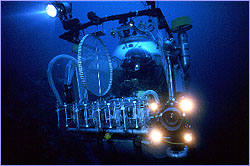 Johnson Sea Link
Johnson Sea LinkIn 1971, the Harbor Branch Oceanographic Institution in Fort Pierce, Florida built this nine-ton, 23-foot long acrylic and aluminum submersible for marine science research. Its applications include mid-water observation, collection of organisms, dump-site inspections, and archaeological site documentation and artifact recovery. The forward sphere holds the pilot and an observer while an additional crew member and observer can occupy the after-observation chamber. In order to illuminate underwater scenes for photography and observation, Harbor Branch developed sunlight-simulating xenon arc lights. In 1973, while being used by another institution, the 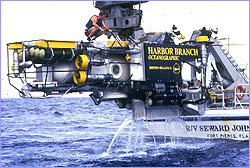 submersible became tangled in the cables of the sunken
destroyer Fred T. Berry. It was trapped for over 24 hours
before the rescue vessel A.B. Wood retrieved it with a
grappling hook. Sadly, two of the four crew members had died
of suffocation. A second Johnson Sea Link was built in
1975.
submersible became tangled in the cables of the sunken
destroyer Fred T. Berry. It was trapped for over 24 hours
before the rescue vessel A.B. Wood retrieved it with a
grappling hook. Sadly, two of the four crew members had died
of suffocation. A second Johnson Sea Link was built in
1975.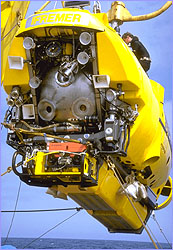 Nautile
NautileNautile is a French submersible operated by the French Institute of Research and Exploitation of the Sea (known by the acronym IFREMER). Holding a crew of three, it is highly maneuverable and includes a small, telecontrolled robot called Robin that can inspect and image areas inaccessible to the submersible itself. Data and imagery from the deep may be sent to the surface via an acoustic transmission unit. In 1987, Nautile, whose manipulation system includes two mechanical arms and a retractable sampling basket, was used to recover thousands of artifacts from the Titanic. 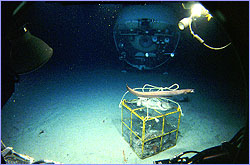 MIR-1 and MIR-2
MIR-1 and MIR-2The submersibles MIR-1 and MIR-2 were built in 1987 and are operated by the Shirshov Institute of Oceanology in Russia. Each vehicle has an iron-nickel battery with a capacity of 100 kilowatts, which is twice as much as is available for other submersibles in the same dive range (to 19,800 feet). The Mirs' high power capacity allows them to undertake underwater work schedules of 17 to 20 hours. Both submersibles carry up to eight 1,200-watt 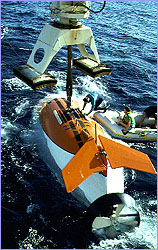 halogen-mercury-iodine lights, which helped them film scenes
of the Titanic for the blockbuster Hollywood movie. The Mirs
have also been used to explore hydrothermal vents and observe
the wreck of the Russian nuclear submarine Komsomolets.
halogen-mercury-iodine lights, which helped them film scenes
of the Titanic for the blockbuster Hollywood movie. The Mirs
have also been used to explore hydrothermal vents and observe
the wreck of the Russian nuclear submarine Komsomolets.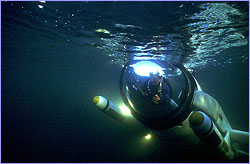 Deep Flight
Deep FlightHawkes Ocean Technologies of Point Richmond, California is currently designing a new class of lightweight submersibles for ocean exploration and filming. Their first prototype, Deep Flight I, is a one-man submersible shaped like a miniature spaceship. The pilot, who must lie face forward in the plastic nose cone, controls depth by manipulating the external aft wings with small joysticks. Due to its winged design and increased thrust, Deep Flight I is capable of traveling up to 10 knots. Though it is several times faster than  traditional submersibles, it can only dive to 3,300 feet.
Hawkes is currently developing Deep Flight II, which will be
able to achieve the greater depths needed for scientific
research in the deep sea.
traditional submersibles, it can only dive to 3,300 feet.
Hawkes is currently developing Deep Flight II, which will be
able to achieve the greater depths needed for scientific
research in the deep sea.Jennifer Uscher is Production Assistant of NOVA Online. Discoveries in the Abyss | Deep Sea Machines | Vents of the World Photos: (1) Ralph White/Corbis; (2,3) ©Woods Hole Oceanographic Institution; (4,5) Ralph White; (6) ©1994 Mark Conlin/Mo Yung Productions; (7) Copyright ©1998 Harbor Branch Oceanographic Institution, Inc.; (8,9) U.S. Navy Historical Center; (10) IFREMER; (11) ©1997 Norbert Wu; (12) Hawkes Ocean Technologies using Mechanical Desktop 2.0. The Mission | Life in the Abyss | The Last Frontier | Dispatches E-mail | Resources | Table of Contents | Abyss Home Editor's Picks | Previous Sites | Join Us/E-mail | TV/Web Schedule About NOVA | Teachers | Site Map | Shop | Jobs | Search | To print PBS Online | NOVA Online | WGBH © | Updated October 2000 |